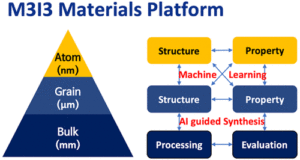Review Article
Publication Types:

Reducing Time to Discovery: Materials and Molecular Modeling, Imaging, Informatics, and Integration
Multiscale and multimodal imaging of material structures and properties provides solid ground on which materials theory and design can flourish. Recently, KAIST announced 10 flagship research fields, which include KAIST Materials Revolution: Materials and Molecular Modeling, Imaging, Informatics and Integration (M3I3). The M3I3 initiative aims to reduce the time for the discovery, design and development of materials based on elucidating multiscale processing–structure–property relationship and materials hierarchy, which are to be quantified and understood through a combination of machine learning and scientific insights. In this review, we begin by introducing recent progress on related initiatives around the globe, such as the Materials Genome Initiative (U.S.), Materials Informatics (U.S.), the Materials Project (U.S.), the Open Quantum Materials Database (U.S.), Materials Research by Information Integration Initiative (Japan), Novel Materials Discovery (E.U.), the NOMAD repository (E.U.), Materials Scientific Data Sharing Network (China), Vom Materials Zur Innovation (Germany), and Creative Materials Discovery (Korea), and discuss the role of multiscale materials and molecular imaging combined with machine learning in realizing the vision of M3I3. Specifically, microscopies using photons, electrons, and physical probes will be revisited with a focus on the multiscale structural hierarchy, as well as structure–property relationships. Additionally, data mining from the literature combined with machine learning will be shown to be more efficient in finding the future direction of materials structures with improved properties than the classical approach. Examples of materials for applications in energy and information will be reviewed and discussed. A case study on the development of a Ni–Co–Mn cathode materials illustrates M3I3’s approach to creating libraries of multiscale structure–property–processing relationships. We end with a future outlook toward recent developments in the field of M3I3
New modalities of strain-control of ferroelectric thin films
Ferroelectrics, with their spontaneous switchable electric polarization and strong coupling between their electrical, mechanical, thermal, and optical responses, provide functionalities crucial for a diverse range of applications. Over the past decade, there has been significant progress in epitaxial strain engineering of oxide ferroelectric thin films to control and enhance the nature of ferroelectric order, alter ferroelectric susceptibilities, and to create new modes of response which can be harnessed for various applications. This review aims to cover some of the most important discoveries in strain engineering over the past decade and highlight some of the new and emerging approaches for strain control of ferroelectrics. We discuss how these new approaches to strain engineering provide promising routes to control and decouple ferroelectric susceptibilities and create new modes of response not possible in the confines of conventional strain engineering. To conclude, we will provide an overview and prospectus of these new and interesting modalities of strain engineering helping to accelerate their widespread development and implementation in future functional devices.
